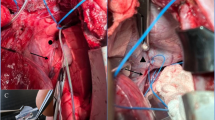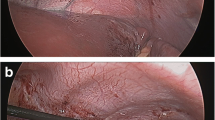Abstract
Background
Electrical stimulation of the phrenic nerve motor point of the diaphragm through laparoscopic implantation of a pacing system is an option for high spinal cord–injured patients with chronic respiratory insufficiency. This study assesses the operative learning curve for the initial series of patients.
Method
A series of six patients underwent laparoscopic placement of a diaphragm pacing system. The operative procedure was divided into the following four steps for analysis and rapid adjustment after each operation: exposure of the diaphragm, mapping of the phrenic nerve motor point, implantation of the pacing electrodes, and final routing of the wires to the external system.
Results
The first case required two operations, and the second case was unsuccessful because of a nonfunctioning phrenic nerve that led to a change in the preoperative screening criteria. The operative time decreased from 469 min for the first operation to 165 min for the sixth operation. The significant time decrease can be attributed to changes in the mapping and routing aspects of the operation. Key changes during this series that helped to reduce the operative time include abandonment of a software-dependent mapping technique, development of a grid algorithm for mapping, software improvement to increase the speed of stimulation and mapping, refinement of the mapping probe to maintain adequate suction on the diaphragm, shortening of the electrode lengths, and experience with the implantation of connections to the external electrodes. Presently, all five of the successfully implanted patients can be maintained on prolonged ventilatory support with the device.
Conclusion
Analysis of every step of this investigational procedure enabled us to make rapid changes in surgical protocol, leading to decreases in operative times and expectant improvements in patient safety and efficacy. In this series, analysis was the key to developing a low-risk cost-effective outpatient diaphragm pacing system.




Similar content being viewed by others
References
H Aiyer TA Stellato RP Onders JT Mortimer (1999) ArticleTitleLaparoscopic implant instruments for the placement of intramuscular electrodes in the diaphragm IEEE Trans Rehab Eng 7 360–371
H Dagash M Choardhury A Pierro (2003) ArticleTitleWhen can I be proficient in laparoscopic surgery? A systemic review of the evidence J Pediat Surg 38 720–724 Occurrence Handle12720179
AF DiMarco RP Onders KE Kowalski ME Miller S Ferek JT Mortimer (2002) ArticleTitlePhrenic nerve pacing in a tetraplegic patient via intramuscular diaphragm electrodes Am Resp Crit Care Med 166 1604–1606
ML Nochomovitz AF Dimarco JT Mortimer NS Cherniack (1983) ArticleTitleDiaphragm activation with intramuscular stimulation in dogs Am Rev Respir Dis 127 325–329 Occurrence Handle1:STN:280:BiyC2M%2FptFw%3D Occurrence Handle6830053
RP Onders AF DiMarco AR Ignagni JT Mortimer (2003) ArticleTitleLaparoscopic placement of diaphragm pacing systems in human subjects Lap SLS Rep 2 22–23
RP Onders H Aiyar JT Mortimer (2004) ArticleTitleCharacterization of the human diaphragm muscle with respect to the phrenic nerve motor points for diaphragmatic pacing Am Surg 70 241–247 Occurrence Handle15055848
RP Onders AF DiMarco AI Ignagni H Aiyer JT Mortimer (2004) ArticleTitleMapping the phrenic nerve motor point: the key to a successful laparoscopic diaphragm pacing system in the first human series Surgery 136 819–826 Occurrence Handle15467667
DK Peterson ML Nochomotivz TA Stellato JT Mortimer (1994) ArticleTitleLong-term intramuscular electrical activation of phrenic nerve: efficacy as a Ventilatory prosthesis IEEE Trans Biomed Eng 41 1127–1135 Occurrence Handle1:STN:280:ByqC2MvosFI%3D Occurrence Handle7851914
DK Peterson ML Nochomotivz TA Stellate JT Mortimer (1994) ArticleTitleLong-term intramuscular electrical activation of phrenic nerve: safety and reliability IEEE Trans Biome Eng 41 1115–1126 Occurrence Handle1:STN:280:ByqC2MvosFE%3D
BD Schmit TA Stellato ME Miller JT Mortimer (1998) ArticleTitleLaparoscopic placement of electrodes for diaphragm pacing using stimulation to locate the phrenic nerve motor points IEEE Trans Rehab Eng 6 382–390 Occurrence Handle1:STN:280:DyaK1M%2FotFCrsQ%3D%3D
Author information
Authors and Affiliations
Corresponding author
Rights and permissions
About this article
Cite this article
Onders, R.P., DiMarco, A.F., Ignagni, A.R. et al. The Learning curve for investigational surgery: lessons learned from laparoscopic diaphragm pacing for chronic ventilator dependence. Surg Endosc 19, 633–637 (2005). https://doi.org/10.1007/s00464-004-8934-6
Received:
Accepted:
Published:
Issue Date:
DOI: https://doi.org/10.1007/s00464-004-8934-6




